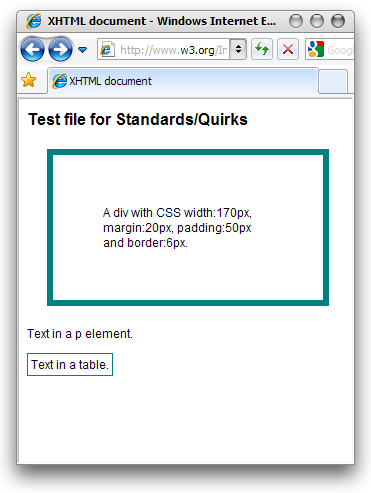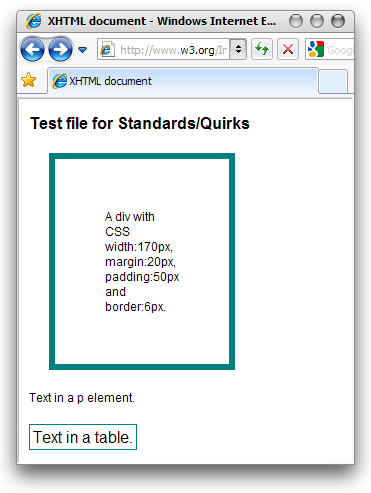'Standards' vs 'Quirks' modes
Current mainstream browsers may display an HTML file in either standards mode or quirks mode. This means that different rules are applied to the display of the file, one conforming to an interpretation of expected behavior according to W3C standards, the other to expectations based on the non-standard behavior of older browsers.
In the latest versions of major browsers, standards mode is turned on by the presence of a DOCTYPE declaration. Lack of a DOCTYPE can lead to different rendering from browser to browser.
The screen captures below illustrate some of these differences.


Click on the pictures to see the actual HTML pages. If you view in Internet Explorer you will see the same effect.
The two pictures show two pages with exactly the same markup and CSS styling, apart from one thing. The only difference between the source of the two files is that the one on the left has a DOCTYPE at the top, and the other doesn't. A file with an appropriate DOCTYPE declaration should normally be rendered in standards mode by recent versions of most browsers. No DOCTYPE, and you get quirks.
The visual differences illustrated above arise from the following implementation differences in a browser such as Internet Explorer:
-
In standards mode the CSS width setting applied to the div does not absorb any widths set for padding and border settings, whereas in quirks mode it does – which is why the large box is wider in the left-most (standards) picture.
-
In quirks mode the table has not inherited the font size setting from the body element, so the text looks larger.
The original use of the DOCTYPE is to indicate the definition of the markup language. The following shows the source text with the DOCTYPE declaration at the top (highlighted in italics).
<!DOCTYPE html PUBLIC "-//W3C//DTD XHTML 1.0 Transitional//EN"
"http://www.w3.org/TR/xhtml1/DTD/xhtml1-transitional.dtd">
<html xml:lang="en" lang="en" xmlns="http://www.w3.org/1999/xhtml">
<head>
<meta http-equiv="Content-Type" content="text/html; charset=utf-8" />
<title>XHTML document</title>
<style type="text/css">
body { background: white; color: black; font-family: arial, sans-serif; font-size: 12px; }
p { font-size: 100%; }
h1 { font-size: 16px; }
div { margin: 20px; width: 170px; padding: 50px; border: 6px solid teal; }
table { border: 1px solid teal; }
</style>
</head>
<body>
<h1>Test file for Standards/Quirks</h1>
<div>
A div with CSS width:170px, margin:20px, padding:50px and border:6px.
</div>
<p>Text in a p element.</p>
<table>
<tr><td>Text in a table.</td></tr>
</table>
</body>
</html>
Browsers that switch in this way between standards and quirks modes are often said to do DOCTYPE switching.
It is generally a good idea to always serve your pages in standards mode – ie. always include a DOCTYPE declaration.
The XML declaration and DOCTYPEs
There is one aspect of using DOCTYPEs that is critically important for character encoding declarations and for predictable styling results.
Because XHTML 1.0 is based on XML, it is possible to add an XML declaration at the beginning of the markup, even if it is served as HTML. This would make the top of the above file look like this (the XML declaration is highlighted in red italics):
<?xml version="1.0" encoding="ISO-8859-1"?>
<!DOCTYPE html PUBLIC "-//W3C//DTD XHTML 1.0 Transitional//EN"
"http://www.w3.org/TR/xhtml1/DTD/xhtml1-transitional.dtd">
<html xml:lang="en" lang="en" xmlns="http://www.w3.org/1999/xhtml">
<head>
...
In browsers such as Internet Explorer 7, Firefox, Safari, Opera, Google Chrome, and others, with or without the XML declaration, a page served with a DOCTYPE declaration will be rendered in standards mode.
With Internet Explorer 6, however, if anything other than a byte-order mark appears before the DOCTYPE declaration the page is rendered in quirks mode.
If Internet Explorer 6 users still count for a significant proportion of your intended audience, this may be an issue. If you want to ensure that your pages are rendered in the same way as on all other standards-compliant browsers, you need to think carefully about how you deal with this.
Obviously, if your document contains no constructs that are affected by the difference between standards vs. quirks mode this is a non-issue. If, on the other hand, that is not the case, you will have to add workarounds to your CSS to overcome the differences, or omit the XML declaration.
Note that if you decide to omit the XML declaration you should choose either UTF-8 or UTF-16 as the encoding for the page. (See Declaring character encodings in HTML for more information about the impact on encoding declarations.)